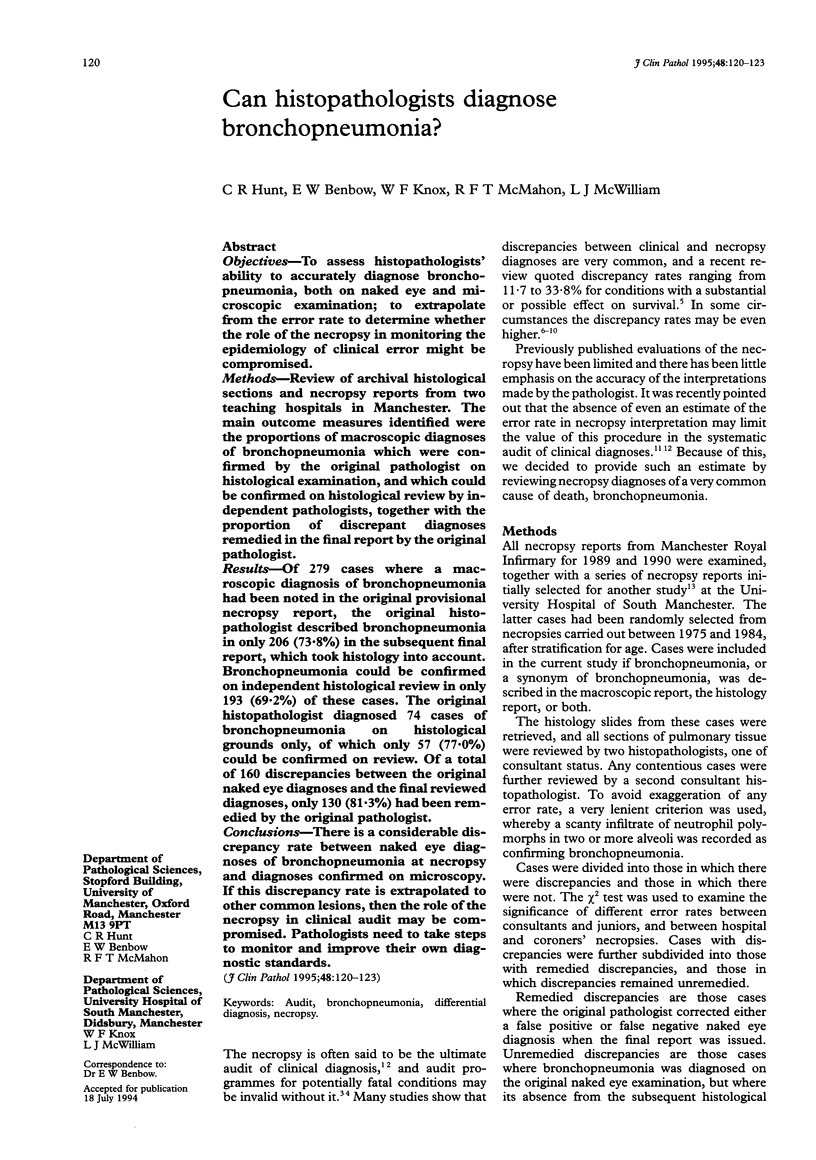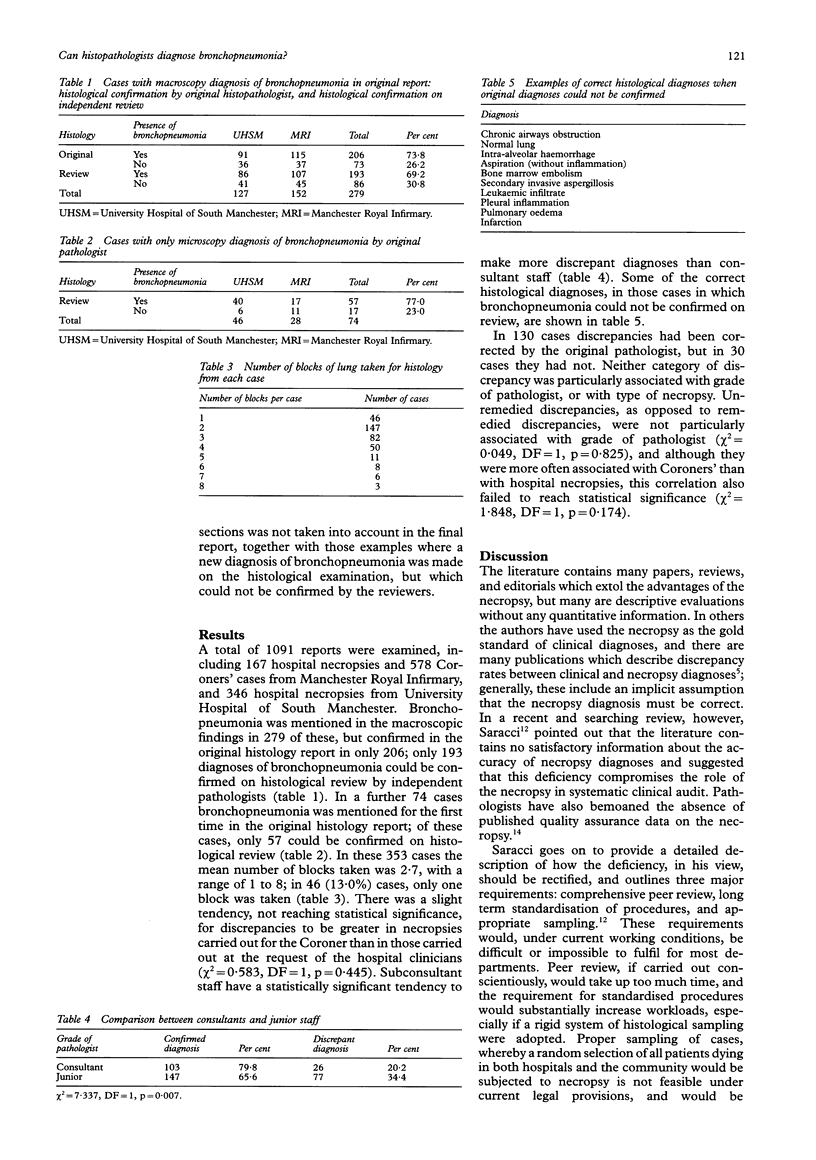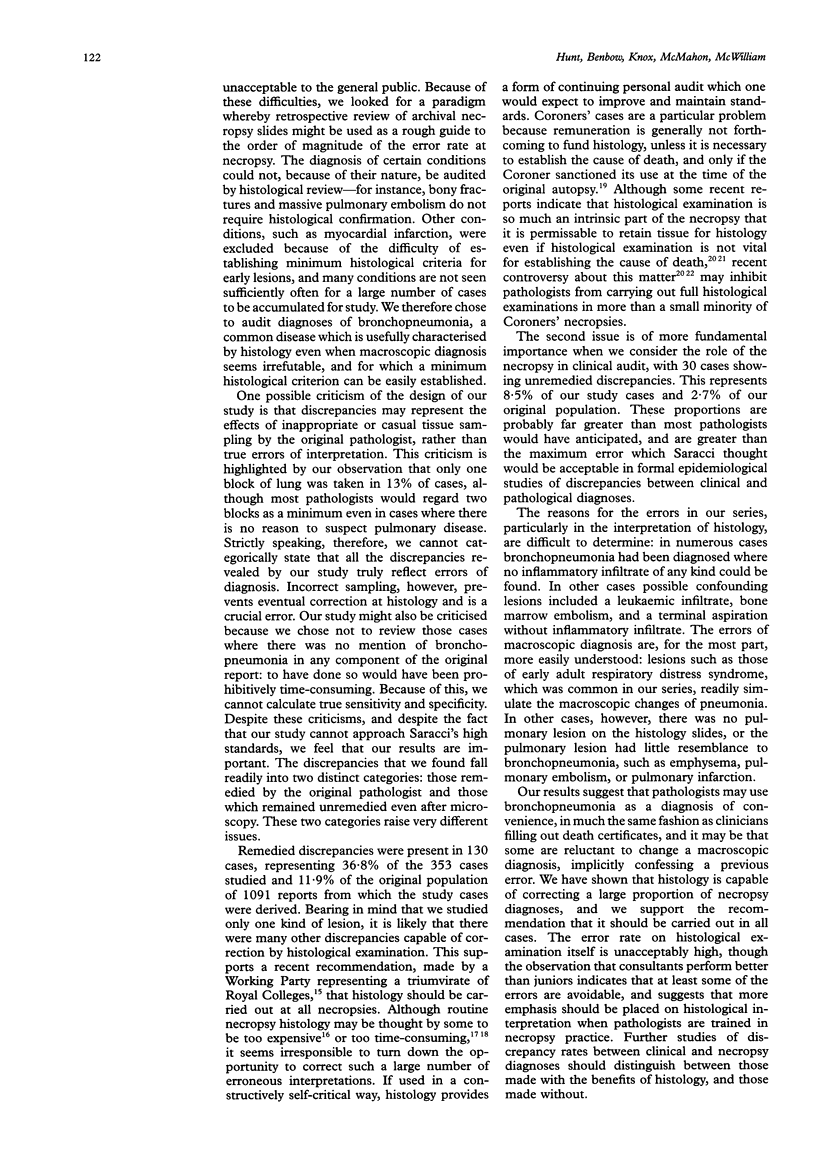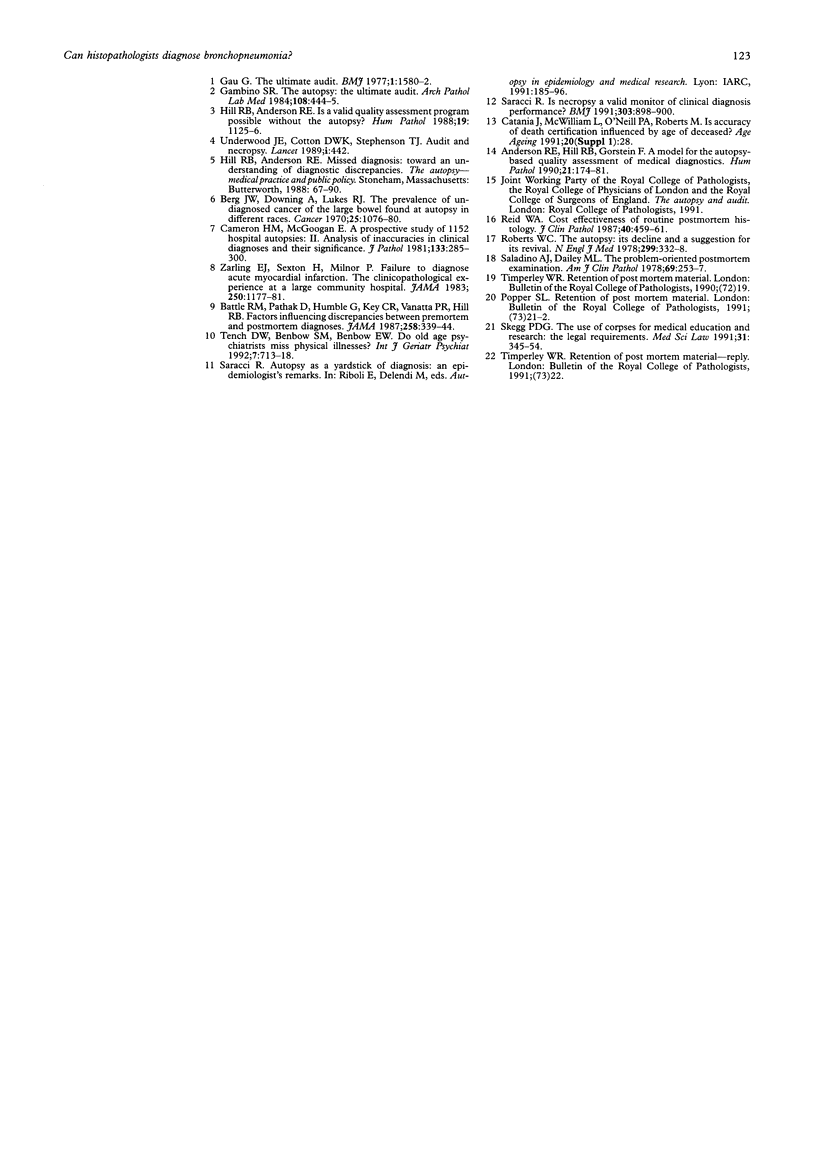Abstract
OBJECTIVES--To assess histopathologists' ability to accurately diagnose bronchopneumonia, both on naked eye and microscopic examination; to extrapolate from the error rate to determine whether the role of the necropsy in monitoring the epidemiology of clinical error might be compromised. METHODS--Review of archival histological sections and necropsy reports from two teaching hospitals in Manchester. The main outcome measures identified were the proportions of macroscopic diagnoses of bronchopneumonia which were confirmed by the original pathologist on histological examination, and which could be confirmed on histological review by independent pathologists, together with the proportion of discrepant diagnoses remedied in the final report by the original pathologist. RESULTS--Of 279 cases where a macroscopic diagnosis of bronchopneumonia had been noted in the original provisional necropsy report, the original histopathologist described bronchopneumonia in only 206 (73.8%) in the subsequent final report, which took histology into account. Bronchopneumonia could be confirmed on independent histological review in only 193 (69.2%) of these cases. The original histopathologist diagnosed 74 cases of bronchopneumonia on histological grounds only, of which only 57 (77.0%) could be confirmed on review. Of a total of 160 discrepancies between the original naked eye diagnoses and the final reviewed diagnoses, only 130 (81.3%) had been remedied by the original pathologist. CONCLUSIONS--There is a considerable discrepancy rate between naked eye diagnoses of bronchopneumonia at necropsy and diagnoses confirmed on microscopy. If this discrepancy rate is extrapolated to other common lesions, then the role of the necropsy in clinical audit may be compromised. Pathologists need to take steps to monitor and improve their own diagnostic standards.
Full text
PDF



Selected References
These references are in PubMed. This may not be the complete list of references from this article.
- Anderson R. E., Hill R. B., Gorstein F. A model for the autopsy-based quality assessment of medical diagnostics. Hum Pathol. 1990 Feb;21(2):174–181. doi: 10.1016/0046-8177(90)90126-p. [DOI] [PubMed] [Google Scholar]
- Battle R. M., Pathak D., Humble C. G., Key C. R., Vanatta P. R., Hill R. B., Anderson R. E. Factors influencing discrepancies between premortem and postmortem diagnoses. JAMA. 1987 Jul 17;258(3):339–344. [PubMed] [Google Scholar]
- Berg J. W., Downing A., Lukes R. J. Prevalence of undiagnosed cancer of the large bowel found at autopsy in different races. Cancer. 1970 May;25(5):1076–1080. doi: 10.1002/1097-0142(197005)25:5<1076::aid-cncr2820250511>3.0.co;2-l. [DOI] [PubMed] [Google Scholar]
- Cameron H. M., McGoogan E. A prospective study of 1152 hospital autopsies: II. Analysis of inaccuracies in clinical diagnoses and their significance. J Pathol. 1981 Apr;133(4):285–300. doi: 10.1002/path.1711330403. [DOI] [PubMed] [Google Scholar]
- Gambino S. R. The autopsy. The ultimate audit. Arch Pathol Lab Med. 1984 Jun;108(6):444–445. [PubMed] [Google Scholar]
- Gau G. The ultimate audit. Br Med J. 1977 Jun 18;1(6076):1580–1581. doi: 10.1136/bmj.1.6076.1580. [DOI] [PMC free article] [PubMed] [Google Scholar]
- Hill R. B., Anderson R. E. Is a valid quality assurance program possible without the autopsy? Hum Pathol. 1988 Oct;19(10):1125–1126. doi: 10.1016/s0046-8177(88)80142-4. [DOI] [PubMed] [Google Scholar]
- Reid W. A. Cost effectiveness of routine postmortem histology. J Clin Pathol. 1987 Apr;40(4):459–461. doi: 10.1136/jcp.40.4.459. [DOI] [PMC free article] [PubMed] [Google Scholar]
- Roberts W. C. The autopsy: its decline and a suggestion for its revival. N Engl J Med. 1978 Aug 17;299(7):332–338. doi: 10.1056/NEJM197808172990704. [DOI] [PubMed] [Google Scholar]
- Saladino A. J., Dailey M. L. The problem-oriented postmortem examination. Am J Clin Pathol. 1978 Feb;69(2 Suppl):253–257. [PubMed] [Google Scholar]
- Saracci R. Is necropsy a valid monitor of clinical diagnosis performance? BMJ. 1991 Oct 12;303(6807):898–900. doi: 10.1136/bmj.303.6807.898. [DOI] [PMC free article] [PubMed] [Google Scholar]
- Skegg P. D. The use of corpses for medical education and research: the legal requirements. Med Sci Law. 1991 Oct;31(4):345–354. doi: 10.1177/002580249103100411. [DOI] [PubMed] [Google Scholar]
- Underwood J. C., Cotton D. W., Stephenson T. J. Audit and necropsy. Lancet. 1989 Feb 25;1(8635):442–442. doi: 10.1016/s0140-6736(89)90039-1. [DOI] [PubMed] [Google Scholar]
- Zarling E. J., Sexton H., Milnor P., Jr Failure to diagnose acute myocardial infarction. The clinicopathologic experience at a large community hospital. JAMA. 1983 Sep 2;250(9):1177–1181. [PubMed] [Google Scholar]


